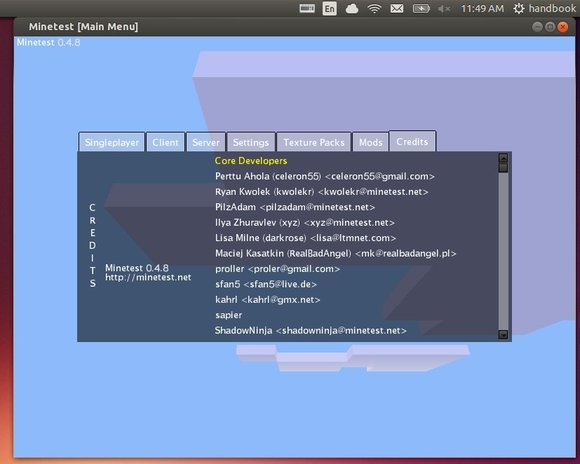Minetest, the open-source Minecraft-like game, has reached v0.4.8 with many new features and bug fixes. Here’s how to install it in Ubuntu 13.10, Ubuntu 13.04, Ubuntu 12.04, Ubuntu 12.10, Linux Mint and their derivatives.
Minetest is designed to be simple, stable and portable. It is lightweight enough to run on fairly old hardware. It currently runs playably on a laptop with Intel 945GM graphics. Though, as for the CPU, dualcore is recommended.
What’s New in Minetest 0.4.8:
Big gameplay changes:
- Added drowning (PilzAdam, RealBadAngel, BlockMen)
- Added weather support (proller)
Smaller gameplay tweaks:
- Added new sounds (someone who can’t decide if he wants to be called mitori or mito551)
- Don’t predict placing and removing nodes if interact privilege is missing (PilzAdam)
Logistic changes:
- Clean up rendering code a bit (increases FPS by 5 to 10) (Exio)
- Added support for IPv6 (matttpt)
- Don’t write player files all the time if they are not modified (PilzAdam)
- Made the main menu Lua based (sapier, kahrl)
- Change static ContentFeatures array into a vector (rathgit, kahrl)
- Allow multiple singleplayer games at the same time (PilzAdam)
- Added texture pack selection to main menu (Novatux)
- Don’t write files directly but rather write to a temporary file that gets renamed after succesfully written; fixes many causes of corrupted files (PilzAdam)
- Adjust the Lua API structure and improve header inclusion to decrease compile time (kahrl)
- Database abstraction, LevelDB support (sfan5, wieszak, xyz)
Visual changes:
- Added support for bumpmapping (RealBadAngel)
- Added diagonal liquid animation (kahrl)
- Damage updates and effects are now sent to other players (PilzAdam)
Other things
- Play
player_damage.oggwhen recieving damage andplayer_falling_damage.oggon falling damage (PilzAdam) - Added basic unicode support to the console in Linux (Exio)
- Added a setting for max loop count per step in liquid update (PilzAdam)
- Added math mapgen with fractal based worlds (proller)
- Disallow the name ‘singleplayer’ in a multiplayer server (PilzAdam)
- Added
max_objects_per_blockto minetest.conf to control the maximum number of static objects per block (Novatux) - Removed broken farmesh (kahrl)
- Added
languagesetting tominetest.confwhich forces Minetest to use specified translation (xyz)
Bug fixes as well as other changes can be found at minetest changelog
Install Minetest
The latest stable version of Minetest is available in launchpad PPA for Ubuntu 13.10, Ubuntu 13.04, Ubuntu 12.10, Ubuntu 12.04 and their derivatives. include Linux Mint 13/14/15/16, Pear OS 8/7, Elementary OS Luna.
To get started, press Ctrl+Alt+T on keyboard to open terminal. When it opens, run commands below one by one:
sudo add-apt-repository ppa:minetestdevs/stable sudo apt-get update sudo apt-get install minetestc55
Once installed, open the game from Dash or menu:
